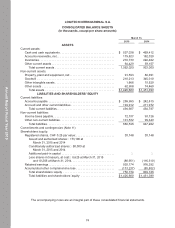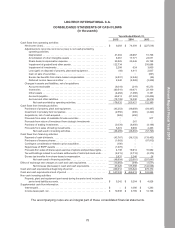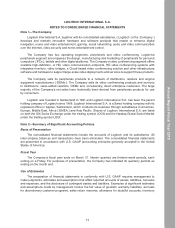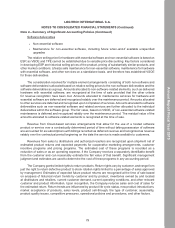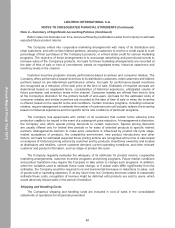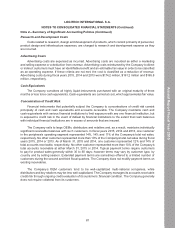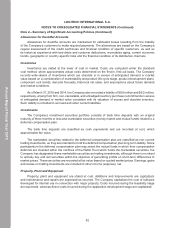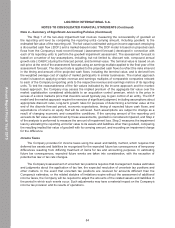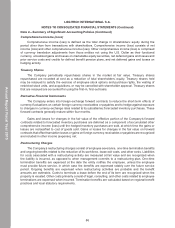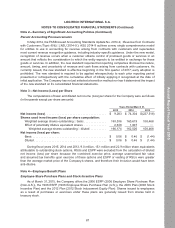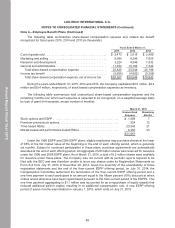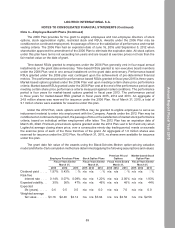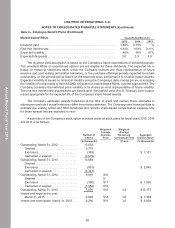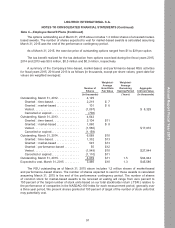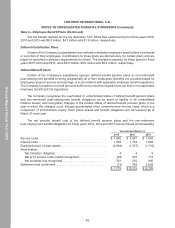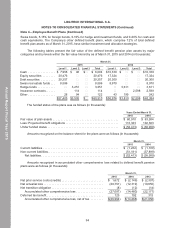Logitech 2015 Annual Report Download - page 200
Download and view the complete annual report
Please find page 200 of the 2015 Logitech annual report below. You can navigate through the pages in the report by either clicking on the pages listed below, or by using the keyword search tool below to find specific information within the annual report.
LOGITECH INTERNATIONAL S.A.
NOTES TO CONSOLIDATED FINANCIAL STATEMENTS (Continued)
The Step 1 of the two-step impairment test involves measuring the recoverability of goodwill at
the reporting unit level by comparing the reporting unit’s carrying amount, including goodwill, to the
estimated fair value of the reporting unit. The fair value is estimated using an income approach employing
a discounted cash flow (“DCF”) and a market-based model. The DCF model is based on projected cash
flows from the Company’s most recent forecast (“assessment forecast”) developed in connection with
each of its reporting units to perform the goodwill impairment assessment. The assessment forecast is
based on a number of key assumptions, including, but not limited to, discount rate, compound annual
growth rate (“CAGR”) during the forecast period, and terminal value. The terminal value is based on an
exit price at the end of the assessment forecast using an earnings multiple applied to the final year of the
assessment forecast. The discount rate is applied to the projected cash flows to reflect the risks inherent
in the timing and amount of the projected cash flows, including the terminal value, and is derived from
the weighted average cost of capital of market participants in similar businesses. The market approach
model is based on applying certain revenue and earnings multiples of comparable companies relevant
to each of the Company’s reporting units to the respective revenue and earnings metrics of its reporting
units. To test the reasonableness of the fair values indicated by the income approach and the market-
based approach, the Company may assess the implied premium of the aggregate fair value over the
market capitalization considered attributable to an acquisition control premium, which is the price in
excess of a stock market’s price that investors would typically pay to gain control of an entity. The DCF
model and the market approach require the exercise of significant judgment, including assumptions about
appropriate discount rates, long-term growth rates for purposes of determining a terminal value at the
end of the discrete forecast period, economic expectations, timing of expected future cash flows, and
expectations of returns on equity that will be achieved. Such assumptions are subject to change as a
result of changing economic and competitive conditions. If the carrying amount of the reporting unit
exceeds its fair value as determined by these assessments, goodwill is considered impaired, and Step 2
of the analysis is performed to measure the amount of impairment loss. Step 2 measures the impairment
loss by allocating the reporting unit’s fair value to its assets and liabilities other than goodwill, comparing
the resulting implied fair value of goodwill with its carrying amount, and recording an impairment charge
for the difference.
Income Taxes
The Company provides for income taxes using the asset and liability method, which requires that
deferred tax assets and liabilities be recognized for the expected future tax consequences of temporary
differences resulting from differing treatment of items for tax and accounting purposes. In estimating
future tax consequences, expected future events are taken into consideration, with the exception of
potential tax law or tax rate changes.
The Company’s assessment of uncertain tax positions requires that management makes estimates
and judgments about the application of tax law, the expected resolution of uncertain tax positions and
other matters. In the event that uncertain tax positions are resolved for amounts different than the
Company’s estimates, or the related statutes of limitations expire without the assessment of additional
income taxes, the Company will be required to adjust the amounts of the related assets and liabilities in
the period in which such events occur. Such adjustments may have a material impact on the Company’s
income tax provision and its results of operations.
Note 2—Summary of Significant Accounting Policies (Continued)
84
Annual Report Fiscal Year 2015


